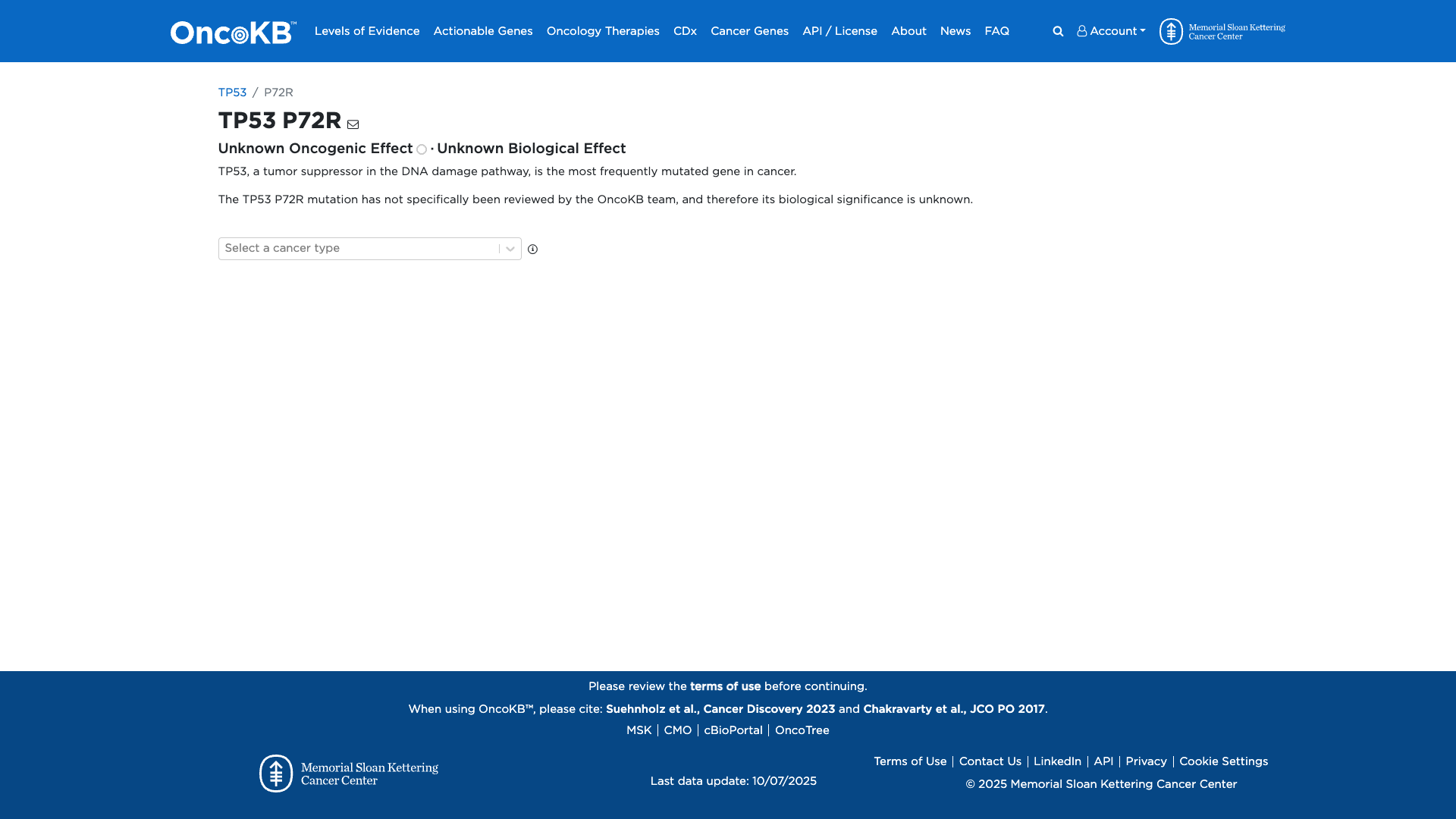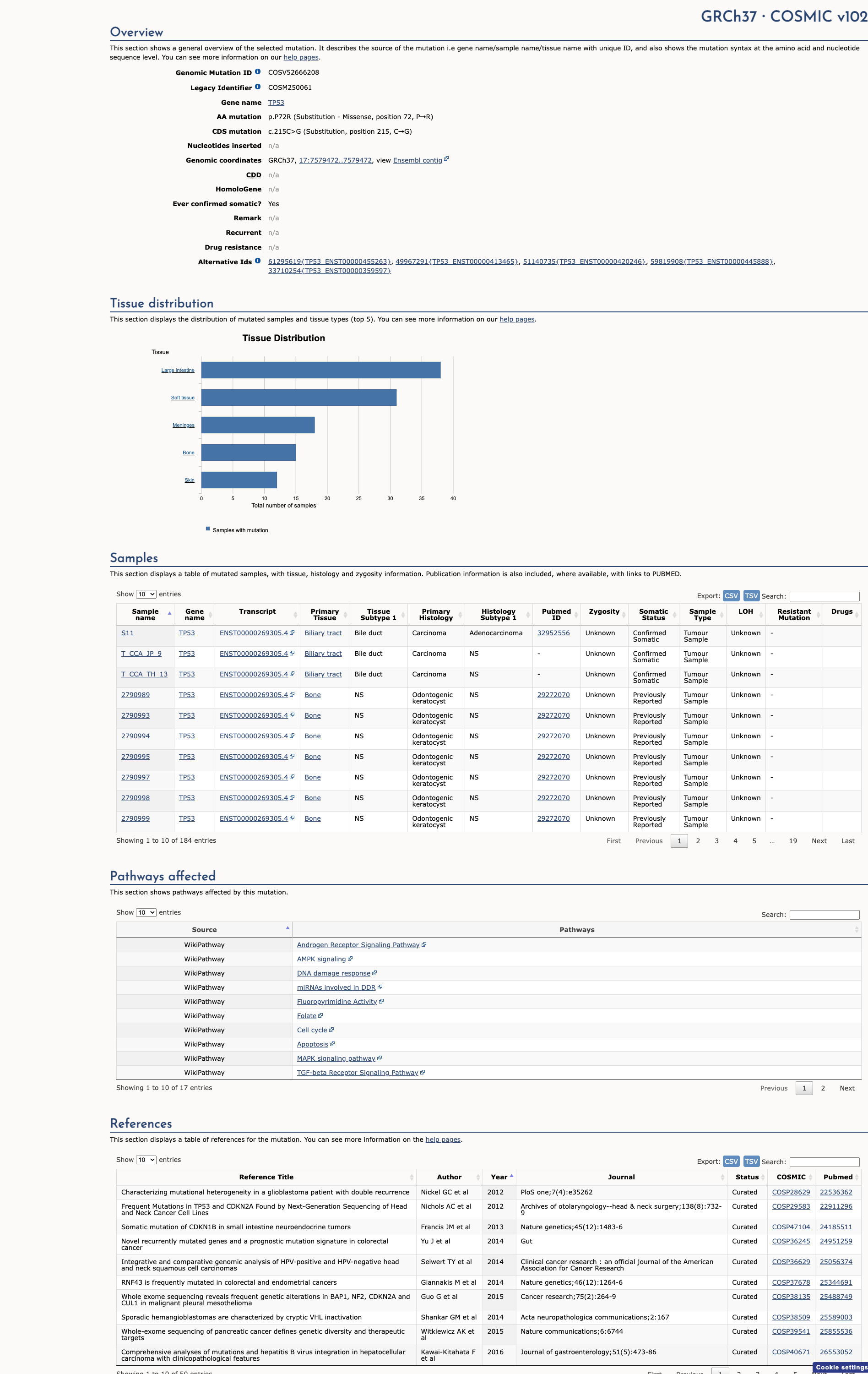TP53 c.215C>G, p.Pro72Arg
NM_000546.6:c.215C>G
COSMIC ID: COSM250061, COSM3766190
Variant of Uncertain Significance (VUS)
This common TP53 polymorphism (P72R) has a very high population frequency (BA1), retains normal function in multiple assays (BS3), and is predicted benign by computational tools (BP4). No pathogenic or segregation evidence exists. These criteria support a Benign classification.
ACMG/AMP Criteria Applied
BA1
BS3
BP4
Genetic Information
Gene & Transcript Details
Gene
TP53
Transcript
NM_000546.6
MANE Select
Total Exons
11
Strand
Reverse (−)
Reference Sequence
NC_000017.10
Alternative Transcripts
| ID | Status | Details |
|---|---|---|
| NM_000546.5 | RefSeq Select | 11 exons | Reverse |
| NM_000546.3 | Alternative | 11 exons | Reverse |
| NM_000546.4 | Alternative | 11 exons | Reverse |
| NM_000546.2 | Alternative | 11 exons | Reverse |
Variant Details
HGVS Notation
NM_000546.6:c.215C>G
Protein Change
P72R
Location
Exon 4
(Exon 4 of 11)
5'Exon Structure (11 total)3'
Functional Consequence
Loss of Function
Related Variants
ClinVar reports other pathogenic variants at position 72: P72L
Alternate Identifiers
COSM250061, COSM3766190
Variant interpretation based on transcript NM_000546.6
Genome Browser
Loading genome browser...
HGVS InputNM_000546:c.215C>G
Active Tracks
ConservationRefSeqClinVargnomAD
Navigation tips: Use mouse to drag and zoom. Click on features for details.
Clinical Data
Global Frequency
66.3%
Common
Highest in Population
European (non-Finnish)
73.7%
Common
Global: 66.3%
European (non-Finnish): 73.7%
0%
0.05%
0.1%
1%
5%
10%+
Allele Information
Total: 281846Alt: 186832Homozygotes: 63926
ACMG Criteria Applied
BA1
This variant is present in gnomAD (MAF= 66.3%, 186832/281846 alleles, homozygotes = 63926) and at a higher frequency in the European (non-Finnish) population (MAF= 73.7%, 94889/128822 alleles, homozygotes = 34940). The variant is common (MAF > 1%), supporting BA1 criterion application.
Classification
2 publications
Uncertain Significance (VUS)
Based on 26 submitter reviews in ClinVar
Submitter Breakdown
1 VUS
25 B
Pathogenic
Likely Path.
VUS
Likely Benign
Benign
Publications (2)
Clinical Statement
This variant has been reported in ClinVar as Benign (25 clinical laboratories) and as Uncertain significance (1 clinical laboratories).
COSMIC ID
COSM250061, COSM3766190
Recurrence
183 occurrences
PM1 Criteria
Applied
Criterion PM1 is applied based on the high recurrence in COSMIC database.
COSMIC Database Preview
Accessing full COSMIC database details requires institutional login or subscription. External links may prompt for authentication.
Functional Impact
Functional Domain
Hotspot Status
Not a hotspot
Domain Summary
This variant is not located in a mutational hotspot or critical domain (0 mutations).
Related Variants in This Domain
ClinVar reports other pathogenic variants at position 72: P72L
PM5 criterion applied.
Functional Summary
The TP53 P72R variant has been functionally studied and shown to decrease Pgc-1a binding, increase mitochondrial function, and enhance migration, invasion, and metastasis in the presence of mutant TP53 in cell culture and mouse models. However, it also transactivates downstream target genes and inhibits cell growth similarly to wild-type TP53 in culture. Thus, the overall effect of the P72R variant on TP53 protein function remains unclear.
Database Previews
OncoKB

JAX-CKB

Click on previews to view full database entries. External databases may require institutional access.
Computational Analysis
Pathogenicity Predictions
REVEL Score
0.368
0.368
Likely Benign0.0
Uncertain (Low)0.2
Uncertain (Med)0.5
Likely Pathogenic0.75
REVEL scores ≥ 0.75 are strong evidence (PP3)
Predictor Consensus
Mixed/VUS
PP3 Applied
No
Additional Predictors
Benign:
CADD: 0.98polyphen_prediction: benignmetasvm: Tmetalr: Tprimateai: T
Neutral: Show all
VCEP Guidelines
Applied ACMG/AMP Criteria (VCEP Specific) VCEP Guidelines
PVS1
PVS1 (Not Applied) Strength Modified
According to VCEP guidelines, PVS1 rule for TP53 is: 'PVS1 applies to null variant (nonsense, frameshift, start codon, splicing +1/2, startgain, single or multi-exon deletion) in a gene where LOF is a known mechanism of disease.' The evidence for this variant shows it is a missense change (P72R) and not a null variant. Therefore, PVS1 is not applied.
PS1
PS1 (Not Applied) Strength Modified
According to VCEP guidelines, PS1 rule for TP53 is: 'PS1 can be applied to variants asserted as Pathogenic following the TP53 VCEP’s specifications.' There is no previously established pathogenic variant with the same Pro72Arg amino acid change. Therefore, PS1 is not applied.
PS2
PS2 (Not Applied) Strength Modified
According to VCEP guidelines, PS2 rule for TP53 is: 'PS2 Very Strong ≥8 points; Strong 4-7 points; Moderate 2-3 points; Supporting 1 point, for de novo occurrence.' There is no evidence of de novo occurrence or confirmed parental relationships. Therefore, PS2 is not applied.
PS3
PS3 (Not Applied) Strength Modified
According to VCEP guidelines, PS3 rule for TP53 is: 'PS3 Strong: Non-functional on Kato et al. data AND loss of function on another assay.' Functional studies show P72R transactivates target genes and inhibits cell growth similarly to wild-type and no consistent loss of function. Therefore, PS3 is not applied.
PS4
PS4 (Not Applied) Strength Modified
According to VCEP guidelines, PS4 rule for TP53 is: 'PS4 Very Strong ≥8 points; Strong 4-7.5 points; Moderate 2-3.5 points; Supporting 1-1.5 points from case-level data.' There is no case-control or proband quantitative data available. Therefore, PS4 is not applied.
PM1
PM1 (Not Applied) Strength Modified
According to VCEP guidelines, PM1 rule for TP53 is: 'PM1 Moderate: Missense variants within codons 175, 245, 248, 249, 273, 282.' Codon 72 is not within these hotspots. Therefore, PM1 is not applied.
PM2
PM2 (Not Applied) Strength Modified
According to VCEP guidelines, PM2 rule for TP53 is: 'PM2 Supporting: Allele frequency <0.00003.' The variant MAF in gnomAD is 66.3%, far above threshold. Therefore, PM2 is not applied.
PM3
PM3 (Not Applied) Strength Modified
According to standard ACMG guidelines, PM3 rule is: 'Detected in trans with a pathogenic variant for a recessive disorder.' TP53‐related cancer predisposition is autosomal dominant, so PM3 is not applicable. Therefore, PM3 is not applied.
PM4
PM4 (Not Applied) Strength Modified
According to standard ACMG guidelines, PM4 rule is: 'Protein length changes due to in‐frame indels or stop‐loss variants.' This variant is missense and does not alter protein length. Therefore, PM4 is not applied.
PM5
PM5 (Not Applied) Strength Modified
According to VCEP guidelines, PM5 rule for TP53 is: 'Moderate: Missense variant at an amino acid residue where one different missense variant previously determined to be pathogenic has been seen.' No pathogenic variant has been reported at codon 72. Therefore, PM5 is not applied.
PM6
PM6 (Not Applied) Strength Modified
According to standard ACMG guidelines, PM6 rule is: 'Assumed de novo without confirmation of paternity and maternity.' No de novo data are available. Therefore, PM6 is not applied.
PP1
PP1 (Not Applied) Strength Modified
According to VCEP guidelines, PP1 rule for TP53 is: 'Supporting: cosegregation in 3–4 meioses; Moderate: 5–6; Strong: ≥7.' No family segregation data are available. Therefore, PP1 is not applied.
PP2
PP2 (Not Applied) Strength Modified
According to standard ACMG guidelines, PP2 rule is: 'Missense variant in a gene with low rate of benign missense variation.' TP53 has a high rate of known pathogenic missense variants. Therefore, PP2 is not applied.
PP3
PP3 (Not Applied) Strength Modified
According to standard ACMG guidelines, PP3 rule is: 'Multiple lines of computational evidence support a deleterious effect.' In silico predictors are predominantly benign and SpliceAI indicates no splicing impact. Therefore, PP3 is not applied.
PP4
PP4 (Not Applied) Strength Modified
According to standard ACMG guidelines, PP4 rule is: 'Patient’s phenotype or family history is highly specific for a disease with a single genetic etiology.' No phenotype data are provided. Therefore, PP4 is not applied.
PP5
PP5 (Not Applied) Strength Modified
According to standard ACMG guidelines, PP5 rule is: 'Reputable source recently reports variant as pathogenic without provided evidence.' ClinVar submissions report this variant as benign or VUS, not pathogenic. Therefore, PP5 is not applied.
BA1
BA1 (Stand Alone) Strength Modified
According to VCEP guidelines, BA1 rule for TP53 is: 'Stand Alone: FAF ≥0.001 in any gnomAD continental subpopulation.' The variant MAF in gnomAD is 66.3%, well above the threshold. Therefore, BA1 is applied at Stand Alone strength.
BS1
BS1 (Not Applied) Strength Modified
According to VCEP guidelines, BS1 rule for TP53 is: 'Strong: FAF ≥0.0003 but <0.001.' The variant MAF is >0.001 and meets BA1 instead. Therefore, BS1 is not applied.
BS2
BS2 (Not Applied) Strength Modified
According to VCEP guidelines, BS2 rule for TP53 is: 'Strong: ≥8 unrelated females ≥60 years without cancer.' No such healthy adult data are available. Therefore, BS2 is not applied.
BS3
BS3 (Strong)
According to VCEP guidelines, BS3 rule for TP53 is: 'Strong: Functional on Kato et al. data AND no loss of function on another assay.' Functional studies show P72R retains transactivation and no loss of function. Therefore, BS3 is applied at Strong strength.
BS4
BS4 (Not Applied) Strength Modified
According to VCEP guidelines, BS4 rule for TP53 is: 'Strong: Lack of segregation in affected family members.' No segregation data are available. Therefore, BS4 is not applied.
BP1
BP1 (Not Applied) Strength Modified
According to standard ACMG guidelines, BP1 rule is: 'Missense variant in a gene for which primarily truncating variants cause disease.' TP53 disease is driven by missense variation. Therefore, BP1 is not applied.
BP2
BP2 (Not Applied) Strength Modified
According to standard ACMG guidelines, BP2 rule is: 'Observed in trans with a pathogenic variant for a dominant disorder.' No such observations exist. Therefore, BP2 is not applied.
BP3
BP3 (Not Applied) Strength Modified
According to standard ACMG guidelines, BP3 rule is: 'In‐frame deletions/insertions in repetitive regions without known function.' This variant is missense, not applicable. Therefore, BP3 is not applied.
BP4
BP4 (Moderate) Strength Modified
According to VCEP guidelines, BP4 rule for TP53 is: 'Moderate: BayesDel ≤ -0.008 AND SpliceAI < 0.2.' In silico tools including BayesDel predict a benign effect and SpliceAI score is 0.05. Therefore, BP4 is applied at Moderate strength.
BP5
BP5 (Not Applied) Strength Modified
According to standard ACMG guidelines, BP5 rule is: 'Variant found in a case with an alternate molecular basis for disease.' No such data are available. Therefore, BP5 is not applied.
BP6
BP6 (Not Applied) Strength Modified
According to standard ACMG guidelines, BP6 rule is: 'Reputable source asserts benign without evidence.' Although ClinVar reports benign, BP6 is discouraged. Therefore, BP6 is not applied.
BP7
BP7 (Not Applied) Strength Modified
According to VCEP guidelines, BP7 rule for TP53 is: 'Supporting: Synonymous variant outside core splice motif with SpliceAI ≤ 0.1.' This variant is nonsynonymous. Therefore, BP7 is not applied.

